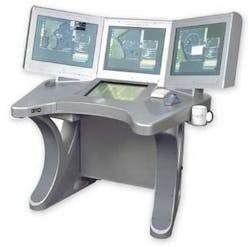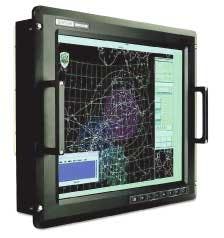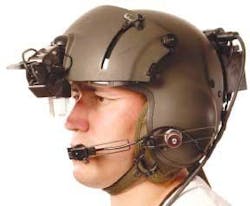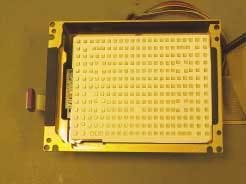Display technology leaps to the next generation
Liquid-crystal displays still dominate military and aerospace applications, and big improvements are on the horizon for this technology. Yet new technologies over the next several years are set to introduce flexible, conformal displays that could be part of clothing or rolled up like a scroll.
Computer displays are everywhere in the Internet Age. The screen is the best way to deploy the most powerful weapon of war — information. As Pentagon leaders strive to network the battlefield, they are placing displays on every surface — not just on ships, planes, and trucks, but on helmets, rifle sights, and radios.
These new applications demand better technology than what has been traditionally available. A display must be more than durable, low cost, and sunlight-readable. Now it also must be lightweight, power efficient, and high resolution.
Display makers solved most of these demands in the mid-1990s by switching from cathode-ray-tube (CRT) to liquid-crystal-display (LCD) technology.
From the size of a postage stamp to a barn door, LCDs are the best answer for military and aerospace applications. LCDs are tough enough to withstand boot kicks, hose sprays, and ultraviolet radiation. They are bright enough to show data in direct sunlight, and can be dim enough to run at night without blinding the soldier with night-vision goggles.
Still, LCD-display makers still have challenges. They face price pressure from mass-market consumer manufacturers making laptops and cellular phones. And they face performance pressure from a fledgling technology called organic light-emitting diodes (OLED).
Dawn of the LCD
Most designers of military and aerospace displays used CRT displays until the mid-1990s, says Mike Forde, senior director of sales and marketing for defense and security at display integrator BarcoView in Duluth, Ga.
In the early 1990s, a few pioneers used small-sized liquid-crystal displays for avionics cockpits, using screens of 4 by 4 inches or 5 by 5 inches. But not until 1997 and 1998 did users of command, control, communications, computers, and intelligence (C4I) systems begin to order large-format LCDs.
Sparking the move was former Defense Secretary William Perry's 1994 initiative to use commercial off-the-shelf (COTS) components instead of custom electronics. For the first time, that shrunk the cost of ruggedizing displays. In 1994, Lockheed Martin won the first AN/UYQ-70 contract (known as Q-70), to supply Navy engineers with open-architecture, COTS displays.
The pace of technology change has slowed since then. Designers at Barco are now improving their displays in three ways: speeding technology refresh, dropping prices, and researching future technologies like OLED.
Technology refresh
The promise of the COTS revolution in military components was to manage obsolescence, refresh technology, and deliver long-term support.
"That means we try to deliver the next model without impacting the customer in fit, form, and function; just make it brighter and lighter, with better viewing angles," Forde says. "We must design products so they're not just backward compatible but also offer opportunities for technology insertion, like including 3-D-capable video cards, although they are not yet widely used."
Designers of C4I applications always ask for the largest display screen that will fit in their consoles, he says. One of Barco's most popular products is the RFD 251, a 20-inch LCD for the Q-70 program. The company has sold 10,000 units this year alone.
To add new technology quickly, Barco engineers now make the modular rugged flat display (MRFD). By relying on a small number of common "modular" parts, Barco engineers can develop a new display in four to six months, as opposed to 15 to 18 months.
In addition to asking for bigger displays, customers often demand lower prices. "They see prices dropping for consumer electronics, and ask why we can't run down to CompUSA and buy a cheaper LCD," he says. "They're forgetting about ruggedization and long-term support."
Still, Barco will respond to this demand by launching a line of low-price, mission-critical and non-mission-critical displays. The first units will sell in the first quarter of 2005.
Future research
Finally, Barco engineers are working on the next generation of display technology. The smart money says that technology will be organic light-emitting diodes (OLEDs).
Supported by a growing commercial infrastructure in Asia and the U.S., the OLED industry promises low-cost, flexible screens. Already, designers of consumer electronics use small OLED screens in wristwatches, microwave ovens, cell phones, and car radios.
That is not good enough for military applications, which need larger screens. "Attempts to make 8- or 10- or 12-inch diagonal screens are just one-offs at trade shows," Forde says. "And they still face hurdles like short lifetime, resistance to humidity, and fading. OLED is not mature enough for the military market."
In the meantime, Barco is building bigger displays for new platforms.
Designers at the U.S. Naval Air Systems Command at Patuxent River Naval air Station, Md., needed large-format displays to control traffic around aircraft carriers. They chose the FD471, a 28-inch, high-resolution active-matrix LCD. It features four field-replaceable backlight trays to ensure image quality and control lifecycle cost. Sailors use the displays to control air traffic from carrier air-traffic-control centers (CATCC) and amphibious air-traffic-control centers (AATC).
Engineers at Boeing Phantom Works in St. Louis, meanwhile, needed a display for mission-control stations for the X-45 Joint Unmanned Combat Air Systems (J-UCAS). Soldiers and sailors will use the screen to monitor visual signals during each mission. They chose Barco's FD251, with its 20.1-inch LCD and specialized bonding technique to produce a sharp liquid-crystal display. Flexible features such as automatic phase adjust and a shop-replaceable backlight tray ensure that each unit can stand up to changing environmental conditions.
Cutting COTS glass
Since the COTS revolution began in 1994, designers of military displays have relied on the consumer electronics market to reduce prices and develop new technologies.
The system most often works well, but military designers say it also has drawbacks. First, commercial displays come in strict shapes and sizes, designed for desktop and laptop computers, not cockpits and consoles. Second, commercial displays are designed for low price and short lifetime, not rugged performance.
The U.S. Display Consortium (USDC) in San Jose, Calif., is an Army-funded industry group that is trying to solve these problems. The U.S. Army Research Laboratory in Adelphi, Md., funds it today, after the U.S. Defense Advanced Research Planning Agency (DARPA) in Arlington, Va., paid for it for its first 15 years.
Planners at the USDC award contracts for joint research, such as a recent grant to General Electric Global Research, Niskayuna, N.Y., to develop a barrier film to protect OLED displays from their sensitivity to moisture and oxygen. Another grant to Lumileds of San Jose, Calif., supports research in using LED backlights to increase the lifetime and reduce the power demand of rear projection displays.
Last January, USDC funders turned their attention to the challenges of designing military platforms with commercial displays. They granted $795,000 to General Dynamics Canada, in Ottawa, Ontario, and Interface Displays and Controls Inc. in Oceanside, Calif.
The grant supports research into "cut COTS," a method of buying COTS active-matrix liquid-crystal displays (AMLCDs), then cutting them down to sizes and shapes that will fit military and aerospace platforms.
To prove that cut-COTS displays can stand up to rugged environments, researchers at General Dynamics will mount a cut-COTS display in a land vehicle. Researchers at Interface will test a similar unit in an aircraft.
"It could save a lot of money," says John Thomas, manager for display technology development at the General Dynamics Canada Vetronics Systems group. He is also the company's representative on U.S. Display Consortium, and is president of their military and avionics user group.
A cut LCD costs $350 to $2,000 per panel, including a couple hundred dollars for cutting and replacing the driver electronics. The total is about one-third the cost of custom solutions, and the performance is nearly as good, he says.
In one example for a medical application, the cost of a cut-COTS solution was $500 to $1,200, compared to $10,000 to $15,000 for a piece of custom glass.
"So you're not held captive by what the laptop market does next," says Chris Chance, manager of business development at General Dynamics Canada. "That will always be cheaper because of the greater quantity. But now with modest investment, we can specialize it for military applications."
Military display designers are also interested in OLED technology. "The Army wants OLED for each soldier as part of their effort to network the battlefield," Thomas says. "Information is everything on the battlefield, so each soldier must get data, and that's primarily communicated through video display. Guys on the ground carry a minimum pack of 70 pounds, and specialists can carry double that. They need power-efficient, lightweight displays that can withstand a guy who's sometimes vertical but often horizontal or jumping around."
Flexible Display Center
So last February, Army leaders awarded $43.7 million to Arizona State University (ASU) to establish the Army Flexible Display Center. In 2009, they could renew funding for a second $50 million, five-year commitment.
The ASU Army Flexible Display Center is a university-industry-government collaboration, featuring industry partners from DuPont Displays, Kodak, Honeywell, General Dynamics, Raytheon, Universal Display Corporation, Kent Displays, E Ink, FlexICs, Three-Five Systems, General Atomics, Optiva, ECD, Southwall, the U.S. Display Consortium, and AGI. They will work alongside academic researchers from Cornell University, the University of Southern California, Penn State University, University of Arkansas, and the University of Arizona Optical Sciences Center.
"The center will be the focal point in a large-scale national effort to provide tomorrow's warfighters with ubiquitous, conformal and flexible displays that are lightweight, rugged, low power and low cost," says Greg Raupp, ASU professor of chemical engineering, Associate Vice President for Research, and director of the center. "These displays will be integrated with computation, communications and global positioning subsystems to significantly enhance the soldier's situational awareness, survivability and effectiveness."
Of course, commercial companies are already pouring $1 billion per year into OLED research, though not necessarily for flexible displays. Companies such as Pioneer, Samsung, Philips, and Dupont are producing glass OLED displays for cell phones, Thomas says. But those applications are just an inch or two across.
"There are 14-inch OLED displays out there, and a 12-inch from Sony, but they are just laboratory curiosities," says Thomas. "Their problems include finite lifetime and differential degradation of materials. It's not there yet; it's a new technology and is immature, but it is the one to watch."
The bottom line is the dominant position of LCDs in all display applications. CRTs are still there but shrinking fast, while OLEDs will dominate research and development for the middle future, he says.
That means engineers at General Dynamics will continue to improve their LCD technology. "The old way to achieve sunlight viewability was to put more light through the backlight. But that causes more heat and demands more power, which are very important factors for portable, battery-powered applications," Chance says.
So General Dynamics engineers have found a way to bond a filter to the display to keep reflection from the front surface to a minimum. They are also creating smart displays, including computing power integrated into the display, which enables military designers to install large display screens in cramped cockpits.
Since inaugurating the AN/UYQ-70 advanced display system in 1994, Navy planners have required their suppliers to use open-architecture, commercial technologies instead of proprietary products.
That approach saves money compared to proprietary systems such as the AN/UYK-7 and related -20, -43, and -44 shipboard computers, since users can deploy the same maintenance equipment and workers for a wide range of computing equipment. It also speeds the upgrade of new technology in programs like the acoustic rapid COTS insertion (ARCI) for the Virginia-class attack submarine.
Future common displays
Now the trend is continuing with the future common display system (FCDS), a planned family of 30 variants of displays and servers. Federal funders plan to issue the request for proposals by the end of 2005, and award a contract by mid-2006.
One of their most difficult decisions is keeping up with new technology, says John Westergren, program manager for rugged computing infrastructure at Lockheed Martin's Maritime Surveillance and Sensor Group, Tactical Systems Group, in Eagan, Minn.
"The Navy's business model used to be keeping computer equipment for 10 years, but now it's five years," Westergren says. "Still, commercial equipment changes faster. Every six to 18 months your laptop goes obsolete. So we have to pick technologies very carefully."
For instance, consumer electronics firms are improving graphics engines for the commercial gaming industry to present three-dimensional pictures on flat screens. Some LCD screens have high-definition television-level resolution. That feature is not important for reading text, but would be crucial for viewing pictures of downtown Baghdad, he says.
"Displays used to be just 580 by 700 pixels, so you couldn't get too granular. Now we have a screen that's 2,000 by 2,000 pixels in our lab so you can take a small square of a picture and blow it up," he says. "That's when you can start looking at license plates and faces when the camera that took the picture is 100 miles or 200 miles away."
Lockheed Martin engineers plan to deliver that technology to military systems designers within one or two years. In the meantime, LCDs are doing the job.
Designers at Lockheed Martin needed a flat-panel display and control interface for crew stations in an upgrade program for the Navy P-3C Orion maritime surveillance airplane. The display had to use surface-acoustic-wave (SAW) touch- screen entry technology to prevent false hits from airborne particles.
They chose a monochrome display from Electro Plasma Inc. (EPI), of Millbury, Ohio. Lockheed Martin has bought 700 of the systems so far.
In June, Lockheed technicians began installing Avionics Modernization program (AMP) kits in Air Force C-5 Galaxy strategic airlifters. The program will cover all 112 aircraft in the fleet over the next several years.
Each AMP kit includes seven 6-by-8-inch LCDs from Honeywell, with six for the pilot and copilot, and one for the flight engineer. The sunlight-readable screens produce minimal heat. Technicians will use them to replace analog equipment with digital displays and cockpit equipment, providing the required avionics for Global Air Traffic Management (GATM) plans.
Demand for large screens
LCD design is about more than just size and cost. "Applications like LCD television in the commercial market is bringing down price, and improving resolution, contrast, response time, and viewing angle. So no way is LCD development finished," says Zel Ulman, director of business development for L-3 Communications Display Systems in Alpharetta, Ga.
Customers often demand reductions in weight and power. L-3 designers can deliver that by using LED backlights instead of fluorescent. They have delivered two or three such designs for avionics applications, and another will soon fly aboard the F-15 fighter jet, he says.
Avionics cockpit designers are trying to deliver more information to each pilot. Since their challenge is to avoid cluttering up a small screen with too much data, they are migrating from 6.8-inch or 10.4-inch diagonal screens to 13- to 14-inch, or even 15- to 17-inch screens.
The only thing more important than screen size may be cost. To keep prices low, L-3 designers have adopted a common size to fit six different programs. Their 10.4-inch diagonal AMLCD flies in the cockpits of the: U-2 spy plane, T-38 supersonic jet trainer, C-130J transport, C-27J Spartan transport, F-5E Tiger jet fighter, and JAS 39 Gripen fighter.
Boeing technicians in 2005 will begin installing L-3's 4-by-3-inch AMLCDs in the cockpits of C-17 Globemaster III airlifter aircraft. Crewmembers in each airplane will use four mission computer display units (DUs) to read data as monochrome alphanumeric text. Displays not only must feature high resolution, high brightness, and night-vision goggle compatibility, but also must support future requirements such as color, graphics, and video.
Looking further down the road, engineers at L-3 Communications are also working on OLED displays.
"That's still a ways off," says Dave Huffman, chief scientist for the advanced programs group. "Not until 2006 will you see OLED in low-volume avionics applications."
Still, leaders at the Air Force Research Lab at Wright Patterson Air Force Base, Ohio, awarded a joint contract this year to L-3 and Universal Display Corp. of Ewing, N.J. Their goal is to create a flexible OLED display for a man-portable communications device.
"Think of it like a laptop in a scroll," Huffman says. "Customers will use flexible OLED where weight and power are a big concern. The dismounted soldier has a lot of weight to carry, much of which is in batteries."
Microdisplays deliver high resolution
Thermal weapon sights enable U.S. Army soldiers to see in nearly any condition, from darkness and bad weather to battlefield smoke and dust.
Soldiers and Marines firing M-16 and M-4 rifles use sights built by Raytheon Co. in Lexington, Mass. Each time they peer through the infrared device, they gaze upon a microdisplay from Kopin Corp. of Taunton, Mass.
Measuring just 0.38-inch diagonal, the CyberDisplay 640M is a rugged AMLCD. Kopin's display, backlight, and electronics serve to convert the output from Raytheon's infrared imaging system, and show the data on a monochrome 640-by-480-pixel screen. Raytheon designers picked it for its low weight, long battery life, and toughness.
Kopin workers are manufacturing 1,100 units per month, although that number is rising quickly under the strain of U.S. military operations, says Mike Presz, vice president and general manager of Kopin's visual products group.
The latest advance in microdisplay performance is a new color-filtering method enabled by nanopixel technology, he says. By shrinking pixels to micron-scale resolution, engineers can combine red, green, and blue signals at a finer scale than ever before.
This Multidomain Vertical Alignment (MVA) liquid-crystal design is ideally suited for night-vision applications, Presz says.
On a typical, twisted-nematic (TN) LCD screen on a laptop computer, pixels fail in the white-colored "on-state." That is all right for office workers, but a pilot flying at night would see a virtual "starry night" image. In contrast, pixels in the new MVA screens fail in the black-colored "off-state," preserving a clear picture.
Researchers at the U.S. Army's Night Vision Laboratory at Fort Belvoir, Va., like the new technology so much that they picked Kopin for a $3.2 million contract in March.
They will use the MVA microdisplays in the Future Force Warrior (FFW) program. Each 0.98-inch diagonal CyberDisplay 1280 CF MVA will deliver enough color and resolution for soldiers to view battlefield information through a head-mounted unit. Soldiers will see a full-size, ultra-wide-angle, HDTV-quality image at 1280-by-1024-pixel resolution.
Army designers will also use it for enhanced night-vision goggles (ENVG), Presz says.
The classic image intensifier on an aviator's helmet amplifies moonlight or starlight, and projects that image on a phosphor screen. Modern thermal imagers, however, can work in complete darkness. Leaders of the ENVG program want to combine the two spectra in one device.
"You can achieve that through an optical overlay, using a beamsplitter to line the images up one over the other. Or you can digitize the intensified image. The thermal image is already digitized, so now you can do signal processing," Presz says.
LEDs glow bright
Commercial platforms such as automotive headlights and traffic signals rely on LED lighting. Until now the technology has not crossed over to military products, yet recent advances in LED technology has produced brighter light than ever before. Military display designers have seized the opportunity to replace the larger, heavier fluorescent units that have always served as backlights.
Engineers are using them in heads-down, heads-up, and helmet-mounted displays, says John Borghese, vice president and general manager for displays, for Rockwell Collins Government Systems in San Jose, Calif.
The Eye HUD HMD is a new, LED-based product from Rockwell Collins, scheduled for flight-testing this summer and launch this fall.
The Eye HUD is a monocular display system designed to provide basic aircraft flight and engine performance data to pilots of helicopter and combat-support aircraft. It relies on the bright new LEDs to reduce weight and cost, and to attach to standard night-vision goggle systems.
At the same time, military designers must be careful to avoid picking commercial technologies that change faster than the military market.
"In the old days, the military was driving the electronics industry, and that's no longer true. It's good because we can take advantage of price and creativity," Borghese says.
"But we must choose architecture with some longevity, at least for interfaces. For example, the PCI, PCI-X, and PCI Express interfaces have longevity of three to five years. But the best graphics chips have longevity of just nine to 18 months. We have created our own chips in the past to lengthen that, but it's very difficult not to tap into the commercial marketplace."
Company information
BarcoView
Duluth, Ga.
www.barco.com
CMC Electronics
Sugar Grove, Ill.
www.cmcelectronics.ca
DRS Technologies
Parsippany, N.J.
www.drs.com
eMagin Corp.
Hopewell Junction, N.Y.
www.emagin.com
EPI Global
Millbury, Ohio
www.epiglobal.com
General Dynamics Canada
Ottawa, Ont.
www.gdcanada.com
Honeywell
Minneapolis, Minn.
www.honeywellaerospace.com
Interface Display and Controls Inc.
Oceanside, Calif.
www.interfacedisplays.com
Kopin Corp.
Taunton, Mass.
www.kopin.com
L-3 Communications Display Systems
Alpharetta, Ga.
www.l-3com.com/displays
Lockheed Martin Maritime Surveillance and Sensor Group
Eagan, Minn.
www.lockheedmartin.com
Lumileds Lighting
San Jose, Calif.
www.lumileds.com
MicroOptical Corp.
Westwood, Mass.
www.microopticalcorp.com
Raytheon Electronic Systems
Dallas, Texas
www.raytheon.com
Rockwell Collins
Cedar Rapids, Iowa
www.rockwellcollins.com
Universal Display Corp.
Ewing, N.J.
www.universaldisplay.com
U.S. Display Consortium
San Jose, Calif.
www.usdc.org
Vision Systems International
Joint venture of Elbit Systems Inc. and Rockwell Collins
Haifa, Israel
www.elbitsystems.com
Xybernaut Corp.
Fairfax, Va.
www.xybernaut.com




